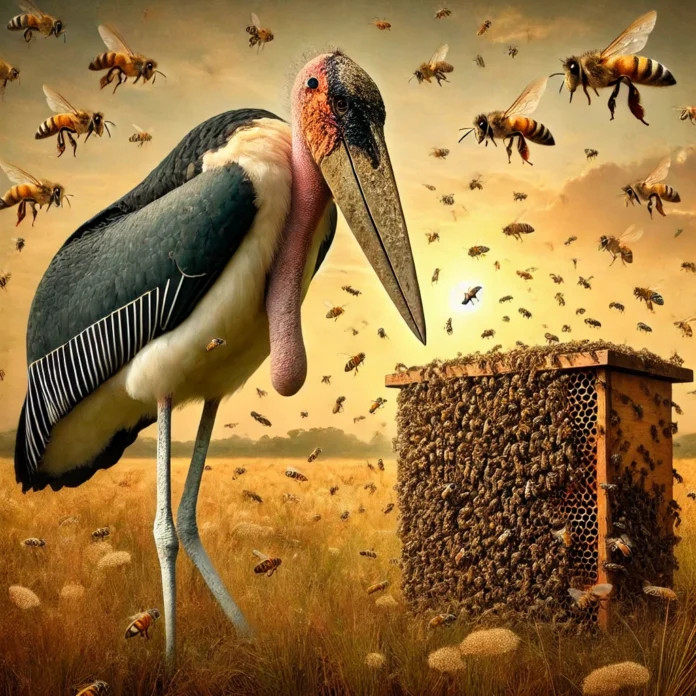Introduction bee/marabou stork
What’s going on with the bee/marabou stork association? Right away, they seem like two totally inconsequential animals. One is a huge, bare headed forager, while the other is a little, humming pollinator. Be that as it may, in nature, even the most surprising creatures can run into each other in entrancing ways. Could these two species influence each other? Or is it simply a case of sharing the same environment? Let’s dive into the world of the bee/marabou stork relationship and uncover the surprising ways they might interact.
Meet the Marabou Stork
Nature’s Undertaker
The marabou stork (Leptoptilos crumenifer) is frequently called “nature’s funeral director” — and for good explanation. With its uncovered head, long legs, and scrounger diet, this bird seems as though it has a place in a Halloween harrowing tale. In any case, don’t be tricked! The marabou stork assumes a fundamental part in tidying up nature’s wreck, forestalling the spread of illness by consuming rotting matter.
Physical Characteristics
Giant Wings and Bald Heads
Marabou storks are Immense. They have a wingspan of more than ten feet and can reach a height of five feet! Their bald heads help them stay clean when digging into carcasses, much like vultures. They also have a strange air sac on their throats that inflates for communication. Creepy? Maybe. But definitely fascinating.
Where Do Marabou Storks Live?
Habitat and Distribution
These birds are local to Africa and are in many cases found close to wetlands, trash dumps, and, surprisingly, human settlements. On the off chance that there’s food lying around — particularly flesh — you’ll probably find a marabou stork close by.
What Do Marabou Storks Eat?
Scavenger Diet
Marabou storks eat almost anything. Rotten meat? Check. Small animals? Sure. Leftovers from a picnic? Absolutely. They’re nature’s cleanup crew, keeping the environment free of decaying waste.
Bee/Marabou Stork: A Strange Encounter
What Happens When They Run into each other?
Since marabou storks aren’t particular eaters, they now and again end up close to bee colonies — particularly while searching for fallen natural product or dead creatures. Honey bees, being savagely regional, don’t generally invite these goliath guests. This unexpected bee/marabou stork interaction can lead to some interesting outcomes!
Bee Behavior: Defenders of the Hive
Swarm Intelligence
Bees don’t back down easily. If a marabou stork gets too close to a hive, worker bees may see it as a threat and launch a full-scale attack. A swarm of angry bees is something even a massive marabou stork wouldn’t want to deal with!
Marabou Storks and Bee Attacks
Do Storks Fear Bees?
Marabou storks aren’t insusceptible to honey bee stings, but at the same time they’re not the most delicate animals. They could shake off a couple of stings, yet a decided multitude could drive them away Unlike some smaller birds, marabou storks rarely raid beehives.
Mutual Benefits or Conflict?
The Ecological Connection
While honey bees and marabou storks don’t have an immediate relationship, their environments cross-over. Marabou storks assist with tidying up dead creatures that could draw in bugs hurtful to honey bees, while honey bees assist with pollinating plants that give food to numerous animals, including creatures marabou storks might search.
Intriguing Marabou Stork Realities
Weird but True!
Marabou storks crap on their legs to remain cool!
They are one of only a handful of exceptional birds that search close by vultures.
Their air sacs assist them with making profound, throaty sounds to convey.
Marabou Storks in Culture and Mythology
Symbolism Around the World
In a few African societies, marabou storks are viewed as signs of death or disaster because of their scary appearance. Others view them as nature’s cleaners, vital for maintaining balance.
Why Marabou Storks Matter
Their Role in the Ecosystem
These birds play a crucial role in waste management. By consuming remains, they assist with forestalling the spread of illness. Love them or disdain them, we really want them!
Threats to Marabou Storks
Human Effect and Preservation Endeavors
In spite of their flexibility, marabou storks face dangers from natural surroundings annihilation and contamination. Protection endeavors center around safeguarding wetlands and decreasing plastic waste, which frequently winds up in their food supply.
Might Marabou Storks at any point Be Useful to Beekeepers?
Surprising Jobs in Beekeeping
Strangely, marabou storks could in a roundabout way help beekeepers by holding rat populaces under wraps. Rodents can obliterate bee colonies, so having a marabou stork around probably won’t be the most exceedingly terrible thing!
Conclusion
The honey bee/marabou stork relationship may not be notable, yet their universes in all actuality do crash in astounding ways. From rummaging to shielding hives, these animals remind us how interconnected nature really is.Whether you find marabou storks enamoring or disturbing, there’s no denying their importance in the climate.
FAQs
1. Do marabou storks eat honey bees?
Not typically. They might eat dead or injured bees, but they don’t actively hunt them.
2. Are marabou storks dangerous?
Not to humans, but they can be aggressive toward other birds when food is involved.
3. Can marabou storks survive bee attacks?
A few stings won’t bother them, but a full swarm could drive them away.
4. Why do marabou storks have bald heads?
Their bald heads prevent feathers from getting dirty while eating carrion.
5. Are marabou storks jeopardized?
No, however they face dangers from contamination and living space obliteration.. Conservation efforts help protect them.

